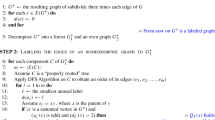Abstract
Given a network G=(V,E), we say that a subset of vertices S⊆V has radius r if it is spanned by a tree of depth at most r. We are interested in determining whether G has a cutset that can be written as the union of k sets of radius r. This generalizes the notion of k-vertex connectivity, since in the special case r=0, a set spanned by a tree of depth at most r is a single vertex.
Our motivation for considering this problem is that it constitutes a simple model for virus-like malicious attacks on G: An attack occurs at a subset of k vertices and begins to spread through the network. Any vertex within distance r of one of the initially attacked vertices may become infected. Thus an attack corresponds to a subset of vertices that is spanned by k trees of depth at most r. The question we focus on is whether a given network has a cutset of this particular form.
The main results of this paper are the following. If r=1, an attack corresponds to a subset of vertices which is the union of at most k stars. We call such a set a galaxy of order k. We show that it is NP-hard to determine whether a given network contains a cutset which is a galaxy of order k, if k is part of the input. This is in stark contrast to the case r=0, since testing whether a graph is k-vertex connected can be done in polynomial time, using standard maxflow-mincut type results.
On the positive side, testing whether a graph can be disconnected by a single attack (i.e. k=1) can be done efficiently for any r. Such an attack corresponds to a single set of vertices spanned by a tree of depth at most r. We present an O(rnm) algorithm that determines if a given network contains such a set as a cutset.
Similar content being viewed by others
References
Agrawal M, Kayal N, Saxena N (2004) PRIMES is in P. Ann Math 160(2):781–793
Chvátal V (1985) Star-cutsets and perfect graphs. J Comb Theory B 39:189–199
Cornuéjols G (2003) The strong perfect graph theorem. Optima 70:2–6
Finbow S, King A, MacGillivray G, Rizzi R (2007) The firefighter problem for graphs of maximum degree three. Discrete Math 307(16):2094–2105
Gunther G (1985) Neighbour-connectivity in regular graphs. Discrete Appl Math 11(3):233–243
Hartnell BL (1995) Firefighter! An application of domination, Presentation. 24th Manitoba Conference on Combinatorial Mathematics and Computing
Kempe D, Kleinberg J, Tardos É (2003) Maximizing the spread of influence through a social network, In: KDD ’03: Proceedings of the ninth ACM SIGKDD international conference on knowledge discovery and data mining, pp 137–146
Khuller S (1995) Approximation algorithms for finding highly connected subgraphs. In: Hochbaum D (ed) Approximation algorithms for NP-hard problems. PWS, Boston, pp 236–265
Kortsarz G, Nutov Z (2007) Approximating minimum cost connectivity problems. In: Gonzalez T (ed) Handbook on approximation algorithms and metaheuristics. Chapman & Hall/CRC, Boca Raton. Chap 58
Sonnerat N, Vetta A (2007) Network connectivity and malicious attacks. Preprint
Author information
Authors and Affiliations
Corresponding author
Rights and permissions
About this article
Cite this article
Sonnerat, N., Vetta, A. Galaxy cutsets in graphs. J Comb Optim 19, 415–427 (2010). https://doi.org/10.1007/s10878-009-9258-1
Published:
Issue Date:
DOI: https://doi.org/10.1007/s10878-009-9258-1




